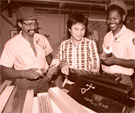
East Asian Painting Conservation Studio
The East Asian Painting Conservation Studio (EAPCS) is one of the few studios in the United States devoted to the conservation of East Asian paintings by traditional methods. Four permanent positions are filled by the core staff of the studio. Three additional temporary positions include an assistant Chinese painting conservator, an assistant Japanese painting conservator and the Hirayama Fellow in Japanese painting conservation. Besides the fundamental role of caring for the Freer and Sackler collections of East Asian painting and calligraphy, the studio conducts a range of educational and cooperative projects through the Hirayama Program for Japanese Painting Conservation and the Chinese Painting Conservation Program.
A Brief History

To reaffirm the Gallery's commitment to the care of its East Asian paintings collection after World War II, three federal positions were created by an act of Congress in 1952 specifically for non-national conservators of East Asian painting. The first was Sugiura Takashi, who worked at the Freer from 1953 until 1980. Since the 1960s, the EAPCS has maintained a staff of two or three Japanese mounters working together. At present the Japanese-trained conservators include Ueda Jiro, Andrew Hare, and Regina Belard.
In 1991, the first Chinese-trained conservator, Gu Xiang-mei, joined the conservation staff—an important step toward balancing the Freer and Sackler Galleries' support of East Asian painting conservation traditions. While maintaining the Galleries' collections of Chinese paintings, Gu has helped train a number of conservators from China, Taiwan, and the West. Grace Jan has been the assistant Chinese painting conservator since 2009.
Cooperative and Educational Programs for East Asian Painting Conservation
The Hirayama Program for Japanese Painting Conservation was started in 2000. The program's endowed funding supports a range of projects dedicated to increasing understanding of the materials and methods of traditional Japanese painting production and mounting while broadening awareness of modern preservation and conservation practices in the United States.
The Chinese Painting Conservation Program, initiated in 2001, is devoted to training young professionals and developing cooperative projects to promote the understanding and care of Chinese paintings. Parallel to these efforts is an ongoing and extensive research program dedicated to the technical study of the materials, structure, and deterioration of East Asian painting.
Such programs are vital to the Freer and Sackler Galleries' efforts to help maintain and advance the rich traditions of Chinese and Japanese mounting and painting conservation in the West. The support for these projects in many ways owes to the strength of the museums' holdings of more than 4,500 East Asian paintings—one of the greatest collections of Chinese and Japanese paintings outside of Asia—and to the long-established role of the Department of Conservation and Scientific Research.
Conservation
OverviewObjects Conservation
Paper Conservation
Exhibitions Conservation
East Asian Painting Conservation Studio
More About the Department
Scientific Research
Scientific research at the Freer and Sackler Galleries is primarily focused on the physical nature of artworks from Asian cultures. More info »
Staff Publications
Publication is an integral part of our research program. Click below to view lists of published works by past and present members of the department:
Online Resources
Safe Handling Practice for Chinese and Japanese Scrolls and Screens
Making East Asian Scroll Storage Boxes (PDF)
Making a Mylar Preservation Roller (PDF)
Making an Ethafoam Preservation Roller (PDF)
Making a Japanese Karibari Drying Board
Report: My Training Here and Abroad - Grace Jan
Conservation of a Nara-period handscroll
Asian Art Connections (PDF)